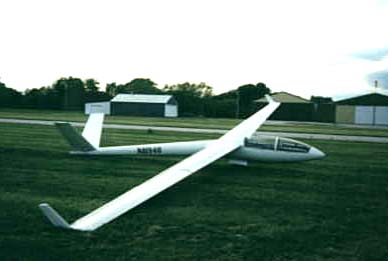N81940

Photo by Greg Dinauer

N81940

Photo by Greg Dinauer

This is a very nice HP-18W built by an auto body specialist, tuned up by a machinist and instrumented by a technoholic. It is everything that could be wanted in a sports class racing glider. 40 to 1 L/D with Masak designed, Collings built winglets. Cambridge Model 10 GPS / LNAV. Becker-Avionics AR3201 Transceiver, Water ballast system that really works more. This aircraft was completed in 1979.
The GPS Mount is fibreglassed in the middle of the ship with the antenna in the nose. Ruddervators were modified by adding a one inch piece of Balsa to stiffen the counterbalance because there was a problem with the paint cracking and it looked terrible. Four layers of fiberglass were placed over the balsa and the ruddervators refinished. It has held up very well. A fibreglassed relief tube was installed under the pilots seat.
Jeff, flew the glider the end of the first year like it was and put the winglets on over that winter. He is not exactly sure how much of an improvement in performance they made but they really look cool. He also modified them a bit by putting Rolerblade wheels in the bottom for operations on pavement. Jeff actually preferred to take off with a wing down after the wheels were installed.
Last winter he did the aileron modification David Colling talked about several years ago in soaring. Basically he rebuilt the aileron top skins putting in a ľ inch spacer bringing the ailerons flush with the top of the wing skin and rolling the aileron into the wing like on fiberglass machines. There was a beryllium gap seal on the wing that bulged up and made the ship turn like a 25 meter machine. The mod better then doubled the roll rate!! He used the old mylar from the bottom of the ailerons and would suggest putting new seals on the top. Cloth tape was used on the bottom of the wing for a gap seal and it has worked very well.
The glider was designed to carry water in the wing spars but never had the plumbing to dump it. Jeff finally figured it out over the winter and got it working very well this spring. Sure makes a difference on strong days.
Assembly is a little more complicated then newer glass ships but rarely takes over 15 minutes including taping the gaps. Being a metal machine it doesnít hurt to leave it out for extended periods. I usually washed and waxed it about once a month. The finish isnít the greatest but it is aerodynamically smooth.
Jeff flew it mainly in the Chicago area with one trip to New Castle VA a couple years ago for a contest. It was a blast on the ridge and very comfortable with the reclined position compared to some of the newer ships who got beat up quite a bit. The landing gear is very rugged and well suited for off field landings should you need it. Jeff did his Gold distance in it this summer and averaged about 3 hours per flight.
(Based on November 1997 email from Jeff Little.)